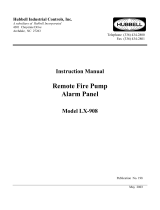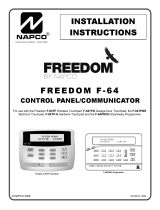ADEMCO 4021 Installation Instructions Manual
- Category
- Security access control systems
- Type
- Installation Instructions Manual
This manual is also suitable for
ADEMCO 4021 is a residential alarm system that provides protection against burglary, fire and other emergencies. The system includes a main control panel, keypad stations, and various sensors.
The main control panel monitors all inputs and generates appropriate output signals. It provides 3 supervised zones of burglary protection, a supervised fire zone, and a twenty-four hour emergency circuit (silent emergency or audible panic). It also provides zone status and alarm memory indications. The entry delay may be reduced to zero. A built-in speaker in the No. 4021 provides audible alarm annunciation.
ADEMCO 4021 is a residential alarm system that provides protection against burglary, fire and other emergencies. The system includes a main control panel, keypad stations, and various sensors.
The main control panel monitors all inputs and generates appropriate output signals. It provides 3 supervised zones of burglary protection, a supervised fire zone, and a twenty-four hour emergency circuit (silent emergency or audible panic). It also provides zone status and alarm memory indications. The entry delay may be reduced to zero. A built-in speaker in the No. 4021 provides audible alarm annunciation.















-
 1
1
-
 2
2
-
 3
3
-
 4
4
-
 5
5
-
 6
6
-
 7
7
-
 8
8
-
 9
9
-
 10
10
-
 11
11
-
 12
12
-
 13
13
-
 14
14
-
 15
15
ADEMCO 4021 Installation Instructions Manual
- Category
- Security access control systems
- Type
- Installation Instructions Manual
- This manual is also suitable for
ADEMCO 4021 is a residential alarm system that provides protection against burglary, fire and other emergencies. The system includes a main control panel, keypad stations, and various sensors.
The main control panel monitors all inputs and generates appropriate output signals. It provides 3 supervised zones of burglary protection, a supervised fire zone, and a twenty-four hour emergency circuit (silent emergency or audible panic). It also provides zone status and alarm memory indications. The entry delay may be reduced to zero. A built-in speaker in the No. 4021 provides audible alarm annunciation.
Ask a question and I''ll find the answer in the document
Finding information in a document is now easier with AI
Related papers
-
ADEMCO Vista-10SEa User manual
-
ADEMCO 1025 Installation Instructions Manual
-
ADEMCO 1026 Installation Instructions Manual
-
ADEMCO Vista-15P SeriesVista-20P Series User manual
-
ADEMCO 5240-12 Installation guide
-
ADEMCO 1025 Installation Instructions Manual
-
ADEMCO VISTA-100 User manual
-
ADEMCO Vista-128BP Installation And Setup Manual
-
ADEMCO Security System VISTA-15CN Installation guide
-
ADEMCO VISTA-10PSIA User manual
Other documents
-
Interlogix JDS108 Installation guide
-
Altronix ALSD1 Datasheet
-
 Metron/Metron-Eledyne HCLX-908 Installation guide
Metron/Metron-Eledyne HCLX-908 Installation guide
-
Hubbell LX908 User manual
-
Wen 4021 User manual
-
bolid Signal-10 User manual
-
FBII XL-2T Installation And Setup Manual
-
Apex Digital K1106 User manual
-
 Napco Security Technologies Gemini GEM-P1664 User manual
Napco Security Technologies Gemini GEM-P1664 User manual
-
 Napco Security Technologies WI1501A User manual
Napco Security Technologies WI1501A User manual

















